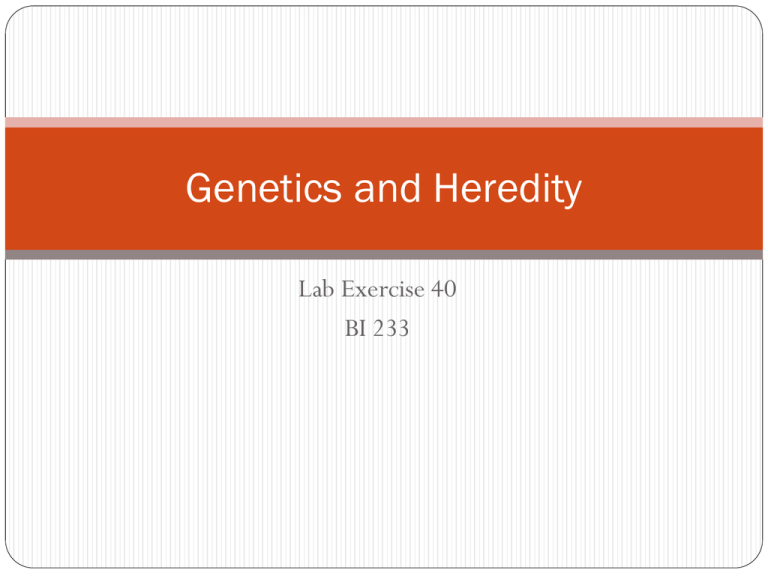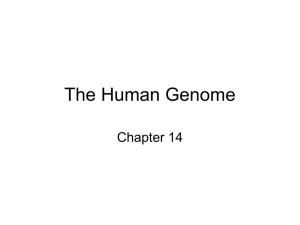Genetics and Heredity
advertisement

Genetics and Heredity Lab Exercise 40 BI 233 Genome All of the genes in all of the chromosomes together are called the genome The study of all the genes in the human species is called genomics Definitions Heredity = the inheritance of traits Genetics = the study of mechanisms of heredity. Genes: A portion of a DNA strand that functions as a hereditary unit, is located at a particular site on a specific chromosome, and codes for a specific protein or polypeptide Gene Expression A person has two genes for every inherited characteristic. If one gene is always expressed, geneticists call that gene dominant. A gene that is not expressed when its mate is different is termed a recessive gene Gene expression Codominance is the condition in which an individual heterozygous for a gene exhibits the phenotypes of both homozygote's (example AB blood) Incomplete dominance is when neither of two alleles is completely dominant.(example: sickle cell anemia at organism level) Gene Expression Polygenic inheritance occurs when two or more genes whose additive effects determine a particular trait.(skin color) Multi allelic inheritance: refers to different versions of one trait on the same gene (Blood types) Inherited characteristics The characteristic actually expressed in an individual is called a phenotype. The genetic constitution of an individual, along with environmental influences is called the genotype. If both genes for a trait are the same the individual is homozygous. If genes are not the same they are heterozygous. Genes and Chromosomes The position of a gene on a chromosome is called a locus. Genetic maps show the relative locations of genes along the chromosome. There can be alternate versions of genes called alleles which produce different phenotypes Centromere Each chromosome often has a constriction along its length called a centromere. The shorter arm is placed on top in a karyotype and is called the p arm, the longer arm is on the bottom and is called the q arm. Numbered regions and subregions are then assigned from the centromere outward The breast cancer gene BRCA1 is located at 17q21 meaning that it is on the long arm of chromosome 17 in the region of 21 Used for gene mapping Chromosomes We inherit 23 DNA molecules from our mothers and 23 DNA molecules from our fathers for a total of 46. 22 pairs of these chromosomes are called autosomes The remaining pair are called sex chromosomes. Taste differences Sodium benzoate test – The ability to taste something sweet, salty, or bitter in the paper is dominant. PTC (phenylthiocarbamide) test The ability to sense a bitter taste is dominant. Thiourea test – the ability to taste something bitter is dominant Anatomical characteristics of hand Bent little finger – If distal phalanx of the little finger bends toward the fourth finger, you have dominant trait. Middigital hair – hair on middle phalanges is dominant. Hitchhiker’s thumb- If you can hyperextend the distal joint of the thumb noticeable, you have the recessive trait. Facial Features Pigmented anterior of the iris – If you have pigment on the anterior and posterior of the iris, your eyes are green, brown, black and hazel. If you lack pigment on the anterior aspect of the iris, yours eyes are blue or grey. Pigmentation is dominant Phenotypes of facial features Attached earlobes – Lobe of the ear is attached rather than free, you have the recessive trait. Widow’s peak – hairline straight across forehead is recessive trait Tongue roll – curling tongue is dominant Freckles – if your face is free of freckles you have the recessive form of this characteristic ABO blood types There are two dominant genes for ABO blood types Type A (IA):signifies the A antigen Type B (IB): signifies the B antigen. Type O (i): is recessive to both Type A and Type B A person with Type A blood can have IAIA or IAi Type B blood can have IBIB or IB i Rh Blood Type The presence of the Rh antigen is dominant Karyotypes Standard chromosome chart Major clinical genetic tool Chromosomes are presented by size and physical landmarks that appear during mitotic metaphase when DNA is coiled tightly Karyotypes can be used to diagnose many genetic conditions as well as reveal effects of environmental toxins. Non-disjunction problems When the homologous chromosomes or sister chromatids fail to separate at anaphase An extra chromosome is called trisomy and a missing chromosome is called monosomy Trisomy 21 (Down’s syndrome) Signs include impaired physical development; short stature; relatively flat face with a flat nasal bridge and mental retardation Trisomy 13 & 18 are other chromosomal trisomies but fetuses do not usually survive until birth. Turner’s Syndrome XO Have only one sex chromosome Designated as 45,X indicating they have 45 chromosomes and one X chromosome. Not noticeable until puberty when they fail to develop secondary sex characteristics and are usually infertile. Webbed neck About 97% of fetuses with Turner syndrome die before birth. Klinefelter’s Syndrome If an XX egg is fertilized by a Y-bearing sperm the result is an XXY combination. Sterile males with usually average intelligence with undeveloped testes, sparse body hair, usually long arms and legs and enlarged breasts. Often goes undetected until puberty. Chromosome Duplications Fragile X syndrome Caused by repeats on the X chromosomes Most people have about 29 repeats but persons with Fragile X have over 700 repeats due to duplication. A major cause of mental retardation and is found in more males because of the single X chromosomes Translocation defect Different chromosomes exchange or combine parts Exposure to certain viruses, drugs and radiation can cause translocations, but they often arise for no apparent reason. No gain or loss of genetic material is involved Can be a cause of Down’s syndrome when a Robertson translocation produces 3 copies of the long arm of chromosome 21 Pedigree The study of a family tree and the careful compilation of phenotypic records of both families over a number of generations. By studying human families for affected and unaffected members over several generations we can usually tell whether a trait is autosomal recessive or is carried on a sex chromosome. Autosomal Recessive Traits Characteristics: Most affected individuals have unaffected parents All children of two affected individuals are affected The risk of an affected child from a mating of two heterozygotes is 25% Expressed in both males and females Examples: albinism, cystic fibrosis, PKU, etc. Autosomal Dominant Characteristics: Every affected individual should have at least one affected parent Affects males and females equally Two affected individuals may have an unaffected child because most affected individuals are heterozygous. Examples: Huntington disease, Marfan syndrome X-linked recessive Characteristics: Phenotypic expression is much more common in males than females Affect males get the mutant allele from their mothers and transmit it to all their daughters but not to any sons. Examples: colorblindness, hemophilia, muscular dystrophy (some forms) Hemophilia in Royal Family Is this trait autosomal recessive, autosomal dominant or sex linked? How can you tell? Probability Is the likelihood of a the offspring of a particular set of parents will have a certain inherited condition. Genetic counselors work with prospective parents to determine their possible genotypes for a variety of traits and then predict the probability of their children having those traits. Activities Follow the instructions in your lab manual to determine your phenotype for the listed traits. After you have determined your phenotype then determine your possible genotypes. Answer the questions in your lab manual using the Punnett squares and pedigrees Be able to answer questions concerning both karyotypes and pedigrees








![Biology Chapter 3 Study Guide Heredity [12/10/2015]](http://s3.studylib.net/store/data/006638861_1-0d9e410b8030ad1b7ef4ddd4e479e8f1-300x300.png)
